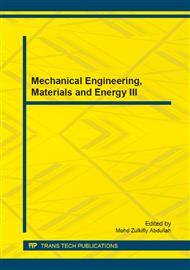[1]
J.M. Garnett, Colors in metal glasses and metal films, Transactions of the Royal Society, London, 1904, pp.385-420.
Google Scholar
[2]
D.A.G. Bruggeman, Berechnung verschiedener physikalischer Konstanten von heterogenen Substanzen.I. Dielektrizitätskonstanten und Leitfähigkeiten der Mischkörper aus isotropen Substanzen, Annalen der Physik 416 (1935) 636-664.
DOI: 10.1002/andp.19354160705
Google Scholar
[3]
A.H. Sihvola, J.A. Kong, Effective Permittivity of Dielectric Mixtures, IEEE T. Geosci. Remote 26 (1988) 420-429.
DOI: 10.1109/36.3045
Google Scholar
[4]
O. Levy, D. Stroud, Maxwell Garnett theory for mixtures of anisotropic inclusions: Application to conducting polymers, Phys. Rev. B 56(1997) 8035-8046.
DOI: 10.1103/physrevb.56.8035
Google Scholar
[5]
B. Drnovšek, V.B. Bregar, M. Pavlin, The effect of complex permeability and agglomeration on composite magnetic systems: A three-dimensional numerical analysis and comparison with analytical models, J. Appl. Phys. 103 (2008) 07D924.
DOI: 10.1063/1.2839580
Google Scholar
[6]
I. Krakovsky, V. Myroshnychenko, Modeling dielectric properties of composites by finite-element method, J. Appl. Phys. 92 (2002) 6743-6748.
DOI: 10.1063/1.1516837
Google Scholar
[7]
V. Myroshnychenko, C. Brosseau, Finite-element method for calculation of the effective permittivity of random inhomogeneous media, Phys. Rev. E 71 (2005) 016701.
DOI: 10.1103/physreve.71.016701
Google Scholar
[8]
Y.B. Sun, J.C. Han, Y.M. Zhang, Relative dielectric constant calculation model for three-phase porous composite materials, Comp. Mater. Sci. 45 (2009) 1125-1128.
DOI: 10.1016/j.commatsci.2009.01.012
Google Scholar
[9]
S.B. Jones, S.P. Friedman, Particle shape effects on the effective permittivity of anisotropicor isotropic media consisting of aligned or randomly oriented ellipsoidal particles, Water Resour. Res. 36 (2000) 2821-2833.
DOI: 10.1029/2000wr900198
Google Scholar
[10]
C. Brosseau, A. Beroual, A. Boudida, How do shape anisotropy and spatial orientation of the constituents affect the permittivity of dielectric heterostructures, J. Appl. Phys. 88 (2000) 7278-7288.
DOI: 10.1063/1.1321779
Google Scholar
[11]
S. Giordano, Effective medium theory for dispersions of dielectric ellipsoids, J. Electrostat. 58 (2003) 59-76.
DOI: 10.1016/s0304-3886(02)00199-7
Google Scholar


